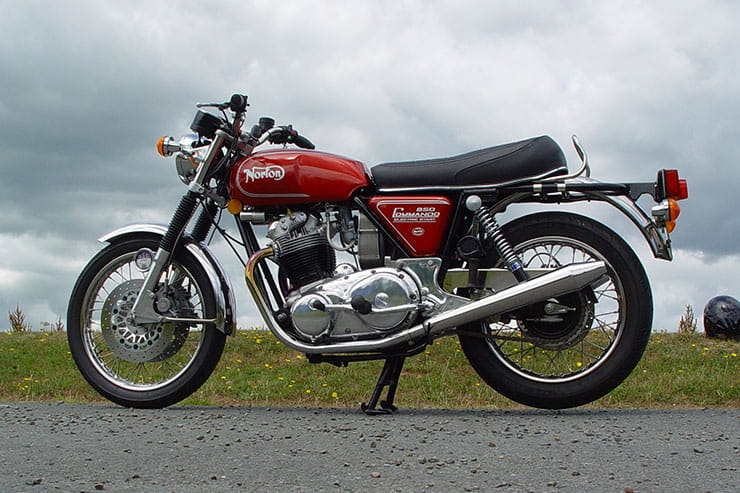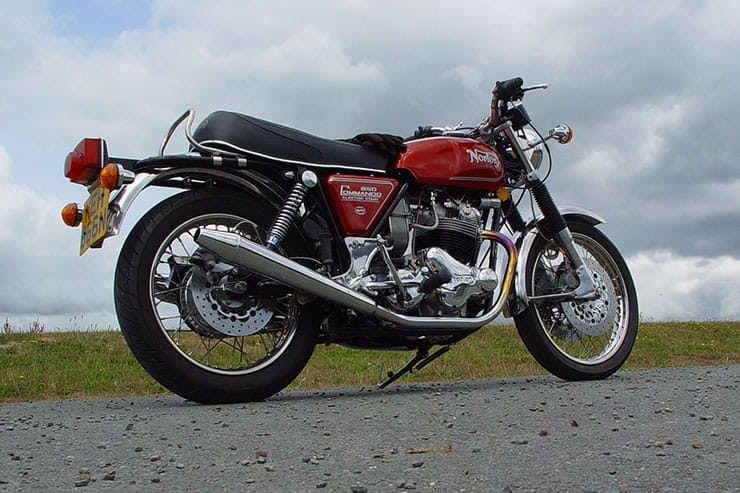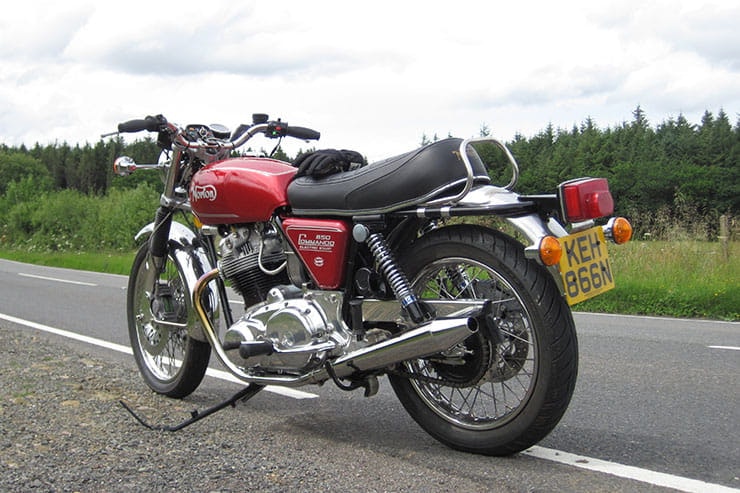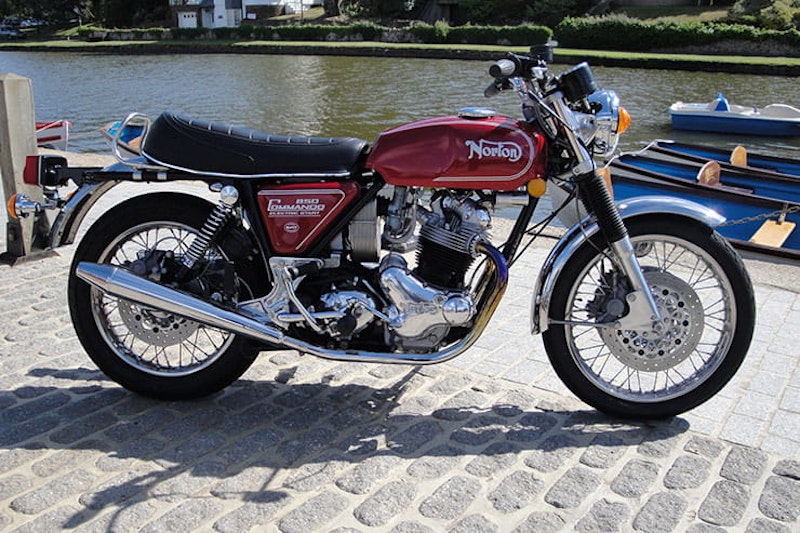Norton Commando 850 Roadster (1975) - Classic Review
By Frank Westworth
Been riding ratty old bikes for so long that when he started writing about them he was the enfant terrible.
14.05.2019
Arguably the greatest of the great British twins, Norton’s Commando reached its final form with the electric-start Mk3 850. It was almost modern for 1975, in some senses…
One thing the late, Great British bike industry was good at was developing a design to the point at which even an amateur – in all senses of the word – must have wondered whether it would have made more sense to simply start again with a fresh design.
Norton were quick into the post-WW2 market with their twin, the Dominator. Why is this important? Because Triumph had shown the one true way just before hostilities broke out, and every rival bike builder in Blighty decided that they needed to follow suit. A good move, in fact. And so it was that Norton unleashed their Model 7 Dominator upon an impoverished post-war world in 1948 and prayed for sales.
It looked neat, rated out at 497cc and delivered a decent 29bhp at a less-than-nifty but OK for the day engine speed of 6000rpm. It was good to ride, too; comfortable and smooth in a relative sense. The Go was OK, and the Stop was too, although the handling was … shall we say, average, with the unlovely ‘plunger’ suspension at the back. No space here to discuss that particular peculiarity, fortunately, except to say that Norton’s enormous record of racing success included using this kind of frame. Mystery is as mystery does.
Development surged ahead in the typically British way, in that the cycle parts changed a lot while the powertrain changed hardly at all except in the inevitable extraction of further power and capacity stakes. By 1967, when the Age Of The Superbike was rushing over the eastern horizon, Norton’s 750, the Atlas, was looking suddenly unsaleable. This was demonstrated by the sad fact that the entire range of products from the parent company was so unsaleable that they went bust. Cue huge sighs of relief from Mr Honda. Not.
Norton’s new owners understood that they needed Something New, and that they needed it Now. Arch-rivals BSA and Triumph had their new 750 triples poised to take on the world, and if Norton was to be something more than a fond memory they needed a new bike. Fast. So they developed one (or more, in fact, but only one seriously). This was adventurous. A dohc parallel twin of a notional 800cc capacity, with the cams driven by one of the longest chains ever seen on a motorcycle. It leaked and shook and rattled and was impossibly difficult to assemble. That was the good news. The bad news was that it made no more power than the Atlas’s 50bhp or so.
Norton’s new guys looked at the mess, used the old Atlas and most of its powertrain, and hung it into a radical rubberised bicycle with flashy modern tank and seat and called it the Commando. And guess what? Despite being a cobble job, the bike was actually brilliant to ride. While Honda were selling shiploads of sohc, 5-speed, electric start, disc-braked four potters, Norton won the MCN Machine Of The Year award for lots of years. Not bad for a pushrod, 4-speed, foot start, drum-braked twin.
The Mk3 you can see here in glorious BS-color was the final development. In less than a decade, Norton had added an electric start and a single disc at each end. They had civilised it at least a little, but at heart it was that 1967 twin with that 1948 engine. Stretched a little, but…
Price
This is that Piece of String question. Again. It always is. Norton Commando prices are insane. Certifiable. You can expect to pay at least £5000 for a total basket case, requiring both a complete rebuild and registering for the UK roads (assuming you’re riding it in the UK). This is because you’re probably going to be restricted to a US model reimported from that great country. Original UK bikes tend to fetch more. Mad but true.
Less mad is the equally remarkable fact that if you do blow around £4k on rebuilding your bike properly – and spares supply is excellent indeed – you should be able to sell it for well north of £10,000. This, gentle reader, is called an investment. But the Mk3 Commando is a lot more than that, far more than an investment. It’s a great riding machine, with all the bottom end grunt of a big twin with low compression and gentle valve timing. No rice pudding is safe near one of these. Think Harley levels of low-rev heave. That’s what you’re paying your ten large for. And if you look after the bike, you’ll not lose money when you move it on. Fairer than that, you cannot say.
Power and torque
There was a great series of ads for Commandos, long ago in the dying days of the old industry. ‘Lotta Torque About Norton’ they claimed. Unusually for ad claims, the statement is accurate and hardly misleading at all. In its final Mk3 form – as seen here – the big Bendy stamped out 48.5 ft/lb at 5000rpm, which is surprisingly high, but maybe 75% of that grunt was available from around 3000rpm. By comparison, the contemporary Honda CB750 K7 delivered 44 ft/lb at 7000rpm, which feels a whole lot different on the road. It’s also interesting to remember that Commandos were drag strip champs for many years, mainly because of their lunging lightning starts. Torque is with you as soon as you twist the grip – as with large capacity American twins.
What this translates to in the real road experience is pretty impressive lift-off. Hardly in the modern superbike way, but very rapid indeed by the standards of the time. The engine delivers its torque in a wild way, with much vigour and tremor and a smoking tyre if that’s what you want.
And on the other hand its low-rev pull is so smooth and gentle that it can be babied along on an only-just open throttle at maybe 15mph, should you be inclined to civilisation. There is however none of this trickling along, clutch home, at walking pace, because the gearing is high. More of that in a minute.
Power is sort-of respectable, if not earth-shattering, even in 1975 or so. From a stock motor you’ll get around 58bhp at 5900rpm – that CB750 K7 supplied 67bhp at 8500rpm. And their on-road performance is similar, strangely enough, not least because the Norton’s kerbside weight of 490lbs compares well with the Honda’s 540lbs. The 850 Commando is a relaxed engine. It does what it does and it does it very well. That said… if you want to have a more fire-breathing and less civilised Commando, go for one of the earlier 750s.
Engine, gearbox and exhaust
When considering any ancient Brit parallel twin it is essential to remember that Triumph were first. And indeed last. All the other competing companies’ designers tried – and often succeeded – to improve on the Triumph original. The Norton twin – as seen here – is like that.
Norton’s boss designer, a fine fellow name of Bert, wanted to improve on the Triumph twin, while producing comparable performance at a comparable price. So, rather than using Triumph’s vintage external tubes to contain the pushrods which prod the overhead valves, he had tunnels cast into the cylinder block. That made the block more expensive, so he saved money by employing just the one camshaft, as opposed to the Triumph’s two. That shaft sits at the front of the engine, spinning in a trough of oil, and is rarely a problem… except when the occasional batch of soft steel was used, but that’s not a design flaw.
The next step was to cure the leaky top end, which was accomplished by casting the head and rockerboxes as one unit, which stops leaks between the top end joints … because there are no top end joints. Again, this makes for an expensive casting, and costs were saved elsewhere by using chains to drive both the single camshaft and the magneto, rather than the expensive precision gears employed by Triumph.
So, we have a neat engine design with fresh thinking applied, gained from several years of experience watching how Triumphs performed in the real world. The first Norton twin engine displaced 497cc from internal dimensions of 66 x 72.6mm. The first of the several stretches came for 1956, when the engine was bored and stroked to 68 x 82mm, providing a rousing 596cc. 1960 introduced a stretched stroke, hefting the twin to 68 x 89mm and 646cc – the first of many Norton 650 twins. By 1962 the inevitable Americans were demanding more cubes and Norton obliged with the first 750 – boring their twin to 73 x 89mm and 745cc. Hurrah.
That engine was used in several models and is in fact a completely cracking device, and when the freshly revived Norton concern was looking for a great new superbike engine to combat Honda and the like… their best efforts were no more powerful. Which is why the first of the Commando line used this engine when 1967 produced Sergeant Pepper and the Norton Commando. Hurrah for both.
Steady development followed, and eventually in 1973 Norton performed the final overbore, taking their venerable engine out to 77 x 89mm and 829cc. A few fairly serious problems with tuned 750s encouraged their new 850 to aim for more torque than power, so the last engines hiked the power from 60bhp at 6500rpm to 58bhp at 5900rpm, which produced the stump-puller we’ve already mentioned. That sounds a little sarcastic, but it’s not. The last of the 850 twins – seen here – is a gloriously relaxed and entirely enjoyable powerplant. It’s even quiet, so quiet that most owners ditched the quiet annular discharge silencers for the earlier ‘pea-shooter’ reversed cone megaphones, as also seen here. A couple more decibels and a couple more ponies too.
It’s difficult to explain how different an engine this is to its Brit competitors. It’s never frantic, never in a rush, never bursting to go faster. But it will run at 4000rpm – 75mph or so – all day, every day. And it’s relaxed and reliable doing this. Not all Brit twins are like this.
The gearbox is another reason for the unique charm of the Commando. Introduced in 1956 and known variously as the AMC gearbox or the Norton gearbox, depending on who’s talking, it stuck steadfastly to its original four speeds, although their spacing changed over years, as you’d hope. The shift is clean and precise, fairly quick for a box of its type, and for the final Mk3 model the shift was … ah … shifted from the conventional Brit right foot to the left, as demanded by those mysterious Americans.
This change in turn dictated a new primary chaincase, with a tensioner for the chain itself and room for all the electric start gubbins.
Did we forget to mention that the final Mk3 Commandos boast that ultra-modern device, the self-starter? Well, it does. And although their reputation was terrible – a joke even – for many years, the fix has been in for many more years now. You know: turn key, apply thumb to switch and click-brumm. It is always a surprise when one works…
It’s too easy to make jokes about the old-fashioned 4-speeder, but that’s actually missing the point in this case. The engine’s wide power delivery and flexibility allow the gearbox to have four very long ratios. None of this top gear as an overdrive nonsense, either. What you get is a rare opportunity explore a whole small world of an exceptional riding style that’s largely missing in these latter days of 6+ speeders.
Exhausts were several. This, the last of the big bangers had a nice simple system, just two headers joined by a balance pipe and with very quiet silencers. Most owners replace this with two headers without the balance and that set of megaphones. So should you.
Handling, suspension, chassis and weight
What exactly do you do when your Brit bike rivals are launching 750 triples and those irritating orientals are whistling over the far horizon with an ohc four? You either improvise, develop, and break new ground… or not. If the latter then you shut up shop and fade away.
Snag was that Norton’s new 800cc ohc twin wasn’t any good, and certainly wasn’t ready. So, displaying remarkable intelligence, the management listened to a pair of their engineers, who insisted that they could magically isolate the rider from the engine’s considerable vibration. Rubber mounting was hardly new, but was rarely satisfactory. Hooper and Favill, those splendid engineers, revealed to a startled board that their system effectively isolated the entire power train – engine, gearbox, swinging arm and rear wheel – from the bits of the bike which contact the rider. There was more. The mountings used to achieve this were adjustable – applying greater or less pressure to the big ‘rubber’ bushings moved the smooth period up and down the engine’s rev range. How clever is that for 1966?
This whole exercise demanded a decent leap of faith. If Norton was worldwide famous for one thing it was their bikes’ excellent, class-leading handling and steering. The central reason for this was the famous ‘featherbed’ frame, which was a double loop device copied by very many other bike builders since its appearance in the early 1950s. Ditching that for something radically different and strange, while retaining the harsh pile-driving vibrator of an engine may appear to be madness But no. It actually worked, and worked better than anyone expected.
The actual main frame was also interesting, comprising a single large diameter tube running from the steering head to under the rider’s backside, where it met up with a pair of slimmer tubes which ran down from the steering head, cradling the engine and gearbox. Front suspension was handled by Norton’s well-proven ‘Roadholder’ fork, the rear by conventional Girling shocks. Nothing remarkable there.
The clever part is the ‘Isolastic’ system. The engine, primary drive and gearbox are held to the frame by three mounting points, the isolation bit being provided by a set of bonded ‘rubber’ bushes. So far, so simple. The swinging arm is mounted in the rear engine plates, which are part of the engine/gearbox assembly and are thus isolated from the frame – the two main mountings are between the front engine plates and the rear plates, which are actually a cradle for the gearbox too. Lots of clever thinking here.
The swinging arm connects to the frame via the rear shocks, which are mounted in rubber bushes. The system didn’t change much, but the Mk3, as seen here, was blessed with a Vernier method of Isolastic adjustment which is a lot easier to use than the earlier shimming arrangement.
And it works really, really well. The engine is a serious vibrator … but it doesn’t matter at all. It can – and does – shudder away to itself between the rider’s knees while she or he enjoys blissful, smooth riding.
The same team developed the rubber mounting system employed by Harley-Davidson on their belt drivers, and that works well too.
Brakes
Very conventional stuff here. Both wheels on the Mk3 are braked by single 10.7-inch discs, feebly gripped by twin-piston Lockheed calipers of variable effectiveness. Upgrades are available, all the way up to the three floating discs and race calipers seen in the pics. Braking is a great thing to upgrade. Oh yes.
Comfort
Mk3 Commandos were mostly delivered in two forms, the Roadster, as in the pics, and the Interstate, which had a vast touring fuel tank and a rearwardly displaced seat to allow it to fit. The sidepanels were also different, but the bikes were mechanically identical. Roadsters got wide bars, so the rider sat upright, with the small tank fitting easily between the knees. It’s very comfortable. Lots of riders fit dropped bars. No idea why.
Slightly more challenging is the Interstate, which typically came fitted with flat touring bars and the rider’s backside rests about six inches further back than on the Roadster. Many people consider this to be a great fast touring posture. Others beg to differ. Changing bars is cheap, footrests less so.
Equipment
As basic as it is traditional. Speedo and tacho (from a couple of different suppliers – just to give concours terrorists the vapours) and a small collection of idiot lights mounted in a neat panel between the clocks. Lucas switchgear and electrical gubbins, but an American Prestolite starter motor. The bike in the pics has a replacement starter which actually works. A Norvil item.



